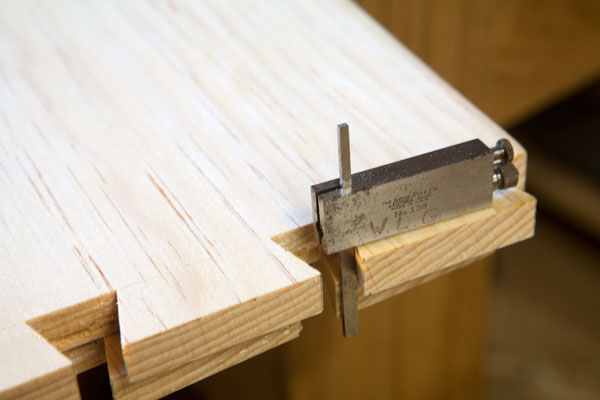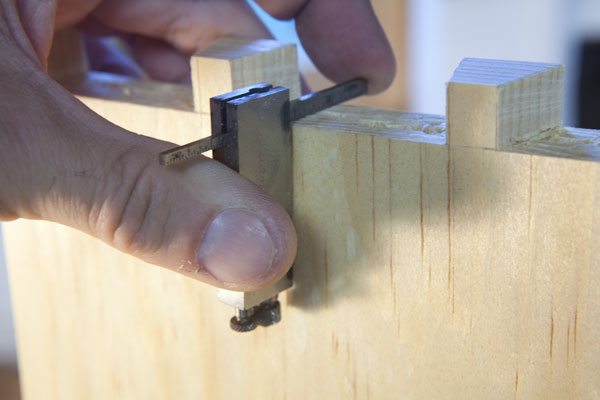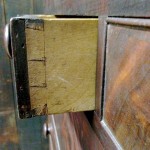We may receive a commission when you use our affiliate links. However, this does not impact our recommendations.
When I teach woodworking, most of my job is diagnosing defective dovetails. Tail walls that are not 90°. Floors of pin and tail boards that have lumps aplenty.
My diagnosis tools are my sensitive fingers, a small square and my eyes.
But in some situations, all of those tools fail. When cutting dovetails with skinny pins, it’s impossible to get a finger or a square into the joint to feel it up. The eye helps, but it usually needs some help.
When I was in Australia in March, almost every student owned one of the incredible Chris Vesper Double Squares. This square had a skinny blade that could reach into any joint and point out with great alacrity (thanks Megan) the problems inside the joint.
I don’t own one of the Vesper squares, though I wish I did. But when I returned home to the States, I remembered that I had an old Lufkin Diemaker’s Square with a similar blade. I’d bought it at a flea market in the 1990s for a ridiculous price ($5?).
Since then, it has become my go-to tool for evaluating the joints of my students. It’s not something I use myself, but if I were a beginning dovetailer, I’d probably want one to double-check my work.
I’ve devised in my head some ways of converting a combination square to hold a skinny blade to do this operation. And I’m sure that you are smart enough to come up with some way of checking your work. And that’s the bottom line: Pay attention. If you aren’t certain your walls are 90° and the floors are flat then you probably should check them.
— Christopher Schwarz
Here are some supplies and tools we find essential in our everyday work around the shop. We may receive a commission from sales referred by our links; however, we have carefully selected these products for their usefulness and quality.












Bite the bullet and pick up one of Chris Vesper’s little squares. You will never regret it.
Chris,
Be careful with your small Lufkin square. one of the screws on the bottom will adjust the arm to be slightly off square. the other tightens the rule to the body. I found this out after playing with a couple I picked up at estate sales or auctions.
Al
Chris, Why would someone want a defective diagnosis whether for dovetails or otherwise?
A 4″ square is one of my all time favorite, most used tools. I use it for layout and as you describe for DTs and other joints. The squared faces of the handle are as useful as the blade and using it as a depth gauge lets me check the bottoms of mortises for high spots.
For narrower things, I can use a cheap depth gauge like this guy http://www.generaltools.com/444–DEPTHANGLE-GAGE_p_585.html . Think of it as a skinny square rather than as a depth gauge. It is not as fancy as what you showed. Still, I think I got it for $15 at Sears or a hardware store. Someone mentioned the Starrett. This is cheaper but similar.
So sorry to read that Chris “borrowed” your Lufkin, Mr. Ghio.
This may come as a shock to most, but I have never cut a dovetail – by machine or hand – in my life. I’ve been butchering wood since ’99. Do I feel as if I have a deep hollow in my very being? Nah. Not really. But, I have books! And a gentleman’s dove tail saw. Chisels…a couple of nifty layout gauges for 6:1 and 8:1. So, with all this chatter about checking troublesome pins and tails for square, I thought I might crack some of those afore mentioned books.
Lo and behold! What do I find in my “Modern Practical Joinery” by George Ellis pg. 67., but an illustration of a “….handy little square for the back and shoulders. It is made either of brass or hardwood 1/8 in. thick, with the edges a a parallel and b at right angles with them.” (I wish I had italics for the a and b).
Now, in the absence of a picture, close your eyes and imagine a rectangle. Now, remove a corner on the short side, and 2/3 along the long side. It looks like a square-cornered key(a toothless key, by the way). The a is the bottom of the key that should have teeth, and the other a is the parallel edge of the head of the key. The b is the right angle going from the head to the long ‘leg’ of the key. Whoa! Tough to describe. If I make one, maybe I can post it here??
I use a Starrett 237 Depth Gauge, Ruler Type.
The squareness of the blade to the base, is useful for checking square dovetails.
That is my Lufkin, by the way. It’s got my initials on it. Since it has been missing, i use a machinist’s depth guage for checking DT’s or mortice walls for square. They are far more common at the fleas.
W.L. Ghio
If you happen to own one of the Czeck Edge Ruler Stops and a small 6″ steel rule, that works pretty well too. I’ve been using mine for that, among other things, ever since I bought it at the Handworks event in Amana last May.
I came up with a simple solution for checking squareness and depth of moulding plane beds. Take a scrap of hardwood, drill a hole in it with a drill press (assuming a squared-up table), then drive in a piece of rigid rod as the gage. I used heavy piano wire for the rod, not having any precision ground stock.
https://twitter.com/maxwellarm/status/328717858307727360/photo/1
Clever. I’ve just been using the Mark I eyeball and the side of a chisel for skinny pins. Time to go talk to the machinists downstairs in the Physics Machine Shop and see if they can make me something in their off time…
So did you turn a burr on it to fix the dovetails?